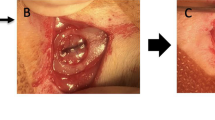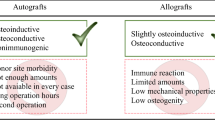Summary
The magnetic porous tricalcium phosphate (MPTCP) and porous tricalcium phosphate (PTCP) ceramic cylinders were implanted into right and left bone defects of rabbits’ radii in order to determine the utility of the MPTCP ceramics. Based on naked eye inspection, light and scanning electron microphotography, roentgenography, quantitative histological measurement of new bone formation and anti-break test for a period of 5 months. The results showed that the two kinds of ceramics were biocompatible with human tissue. MPTCP ceramics could induce more new bone formation than PTCP ceramics. Treatment of fractures with synthetic calcium phosphate ceramics and magnetic fields were discussed.
Similar content being viewed by others
References
Daculsi G, Passuti N, Martin Set al. Comparative study of bioactive calcium phosphate ceramics after implantation in spongy bone in dogs. Histologic ultrastructural and electron probe microanalysis. Rev Chir Orthop, 1989; 75 (2): 65
Goh J C H, Bose K, Kang Y Ket al. Effect of electrical stimulation on the biomechanical properties of fracture healing in the rabbits. Clin Orthop, 1988; 233: 268
Wu H, Zhu T B, Du J Yet al. Analysis of the biocompatibility of magnetic porous tricalcium phosphate ceramics in rat femurs. J Tongji Med Univ, 1992; 12 (2): 111
Urist M R, Bone regeneration under the influence of a bone morphogenetic protein (BMP) beta tricalcium phosphate (TCP) composite in skull trephine defects in dogs. Clin Orthop, 1987t 214: 295
Kitsugi T, Yamamuro T, Takeuchi Het al. Bonding behavior of three types of hydroxyapatite with different sintering temperatures implanted in bone. Clin Orthop, 1988; 234: 280
Hollinger J O, Biodegradable bone repair materials. Clin Orthop, 1986; 207: 290
Duchegne P, Bioceramics: material characteristics versus in vivo behavior. J Biomed Mater Res, 1987; 21 (A2): 219
Sharrard W J, Sutcliffe M L, Robson M Jet al. The treatment of fibrous non —union of fractures by pulsing electromagnetic stimulation. J Bone Joint Surg, 1982; 64-B (2): 189
Bassett C A L, Mitchell S N, Gaston S Ret al. Treatment of ununited tibial diaphyseal fractures with pulsing electromagnetic fields. J Bone Joint Surg, 1981; 63-A (4): 511
Bassett C A L, Pulsing electromagnetic field treatment in ununited fractures and failed arthrodeses, JAMA. 1982; 247: 623
Bassett C A L, The development and application of pulsed electromagnetic field (PEMFs) for ununited fractures and arthrodeses. Orthop Clin North Am, 1984; 15: 61
Lavine L S, Current concepts review. Electrical stimulation of repair of bone. J Bone Joint Surg, 1987; 69-A (4): 626
Bassett C A L, Fundamental and practical aspects of therapeutic uses of pulsed electromagnetic fields (PEMFs). Crit Rev Biomtd Eng, 1989: 17 (5). 451
Haas W G, Beaupre A, Cameron Het al. The Canadian experience with pulsed magnetic fields in the treatment of ununited tibial fractures. Clin Orthop, 1986; 208: 55
Frykman G K, Taleisnik J, Peters Get al. The treatment of nonunited scaphoid fractures by pulsed electromagnetic field and cast. J Hand Surg Am, 1986; 11 (3): 344
Wu H, Zhu T B, Du J Y et al. New bone formation in the in vivo implantation of bioceramics: a quantitative analysis. Chinese Med J, 1992; 105 (9): 753
Author information
Authors and Affiliations
Rights and permissions
About this article
Cite this article
Hua, W., Tong-bo, Z., Jing-yuan, D. et al. Comparison of effects of MPTCP and PTCP ceramics implanted for the treatment of bone defects in rabbits. Journal of Tongji Medical University 15, 98–103 (1995). https://doi.org/10.1007/BF02887911
Received:
Issue Date:
DOI: https://doi.org/10.1007/BF02887911




